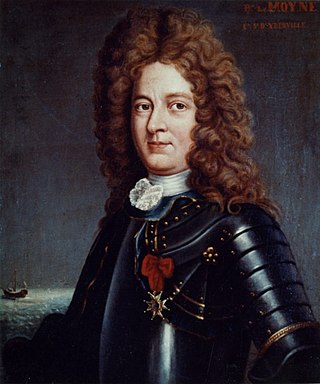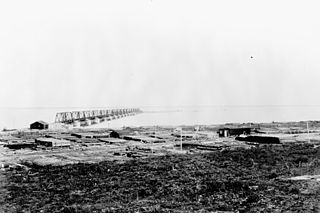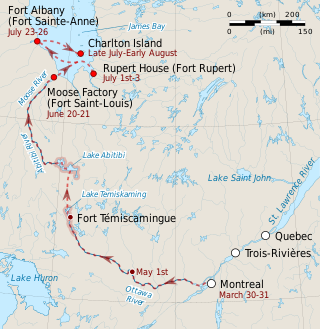Related Research Articles

The Hudson's Bay Company is a Canadian retail business group. A fur trading business for much of its existence, it became the largest and oldest corporation in Canada, and now owns and operates retail stores across the country. The company's namesake business division is Hudson's Bay, commonly referred to as The Bay.

Rupert's Land, or Prince Rupert's Land, was a territory in British North America which comprised the Hudson Bay drainage basin. The right to "sole trade and commerce" over Rupert's Land was granted to the Hudson's Bay Company (HBC), based at York Factory, effectively giving that company a commercial monopoly over the area. The territory operated for 200 years from 1670 to 1870. Its namesake was Prince Rupert of the Rhine, who was a nephew of King Charles I and the first governor of HBC. In December 1821, the HBC monopoly was extended from Rupert's Land to the Pacific coast.

Pierre Le Moyne d'Iberville or Sieur d'Iberville was a French soldier, explorer, colonial administrator, and trader. He is noted for founding the colony of Louisiana in New France. He was born in Montreal to French colonist parents.
Médard Chouart des Groseilliers was a French explorer and fur trader in Canada. He is often paired with his brother-in-law Pierre-Esprit Radisson, who was about 20 years younger. The pair worked together in fur trading and exploration. Their decision to enter British service led to the foundation of the Hudson's Bay Company in 1670. This company established trading posts and extensive relations with the First Nations in western Canada. It was highly influential in making the region amenable to British colonization. Radisson, with Groseiliers, also mapped many of the Great Lakes and trading routes used by settlers.

Events from the 1670s in Canada.

York Factory was a settlement and Hudson's Bay Company (HBC) factory located on the southwestern shore of Hudson Bay in northeastern Manitoba, Canada, at the mouth of the Hayes River, approximately 200 kilometres (120 mi) south-southeast of Churchill.

Fort de la Corne was one of the two French forts established on the Saskatchewan River in the 20 years between the end of La Vérendrye's push west from Lake Superior in 1731–1743 and the fall of New France in 1763.

The Battle of Hudson's Bay, also known as the Battle of York Factory, was a naval battle fought during the War of the Grand Alliance. The battle took place on 5 September 1697, when a French warship commanded by Captain Pierre Le Moyne d'Iberville defeated an English squadron commanded by Captain John Fletcher. As a result of this battle, the French took York Factory, a trading post of the Hudson's Bay Company.
Pierre de Troyes was a captain that led the French capture of Moose Factory, Rupert House, and Fort Albany on Hudson Bay 1686.

Port Nelson was a settlement on Hudson Bay, in Manitoba, Canada, at the mouth of the Nelson River. Its peak population in the early 20th century was about 1,000 people but today it is a ghost town. Immediately to the south-southeast is the mouth of the Hayes River and the settlement of York Factory. Note that some books use 'Port Nelson' to mean the region around the mouths of the two rivers.

Bas de la Rivière is a geographical area on both sides of the Winnipeg River at and near the mouth where it empties into Lake Winnipeg. It had a storied historical period in the opening of the west and the subsequent fur trade and settlement.

The Hudson Bay expedition of 1686 was one of the Anglo-French conflicts on Hudson Bay. It was the first of several expeditions sent from New France against the trading outposts of the Hudson's Bay Company in the southern reaches of Hudson Bay. Led by the Chevalier de Troyes, the expedition captured the outposts at Moose Factory, Rupert House, Fort Albany, and the company ship Craven.

The 1688 Battle of Fort Albany was one of the Anglo-French conflicts on Hudson Bay. In the Hudson Bay expedition (1686) the French had, in time of peace, marched overland from Quebec and captured all three English posts on James Bay. The French had left a garrison at Fort Albany and needed to send a ship to resupply it and take out the furs. The Hudson's Bay Company learned of its loss in January 1687 and appealed to the king. This led to about a year of diplomatic negotiations. In 1688 the Company sent five ships to the Bay. Two went to its remaining post at York Factory, one went to reestablish Rupert House which the French had burned and two went to Fort Albany on the west shore of James Bay. Their instructions were to re-establish the English trade and not to use force against the French unless the French did so first.

The Capture of York Factory was a 1694 Anglo-French conflict on Hudson Bay. In 1686 Pierre Le Moyne d'Iberville marched overland from Québec and captured all the English posts on James Bay. This left York Factory, which was too far away and could only be reached by sea. In 1688 King William's War started and the needed ships were hard to get. In 1690 Iberville tried to take York Factory but was driven away by a larger English ship. In 1694 Governor Frontenac gave him the ships Salamandre and Poli. Iberville reached the Nelson River on 14 September. The fort was invested and on 14 October it surrendered..

The Battle of Fort Albany was an attack by French colonial volunteers and their native allies against the Canadian Hudson's Bay Company outpost of Fort Albany in the southern reaches of Hudson Bay. About 70 Frenchmen and 30 Indians attacked the fort, which was under the command of John Fullartine. Fullartine repulsed the attack, killing eighteen men including the leaders. He lost two men to ambush on their way back to the fort shortly after the attack.
Henley House, the first inland post established by the Hudson's Bay Company, was located in what is now Kenora District, Ontario, Canada. It was strategically situated west of James Bay about 160 miles (257 km) up the east-flowing Albany River at the mouth of the Henley River, 8 miles (13 km) downstream of the confluence of the major north-flowing Kenogami River with the Albany. From the head of the Albany at Lake St. Joseph, a portage led west to Lac Seul from which the English River (Ontario) led to the Winnipeg River and westward. The Kenogami led south toward Wawa, Ontario, but that does not seem to have been a practical canoe route all the way to Lake Superior.
Pedlar is a term used in Canadian history to refer to English-speaking independent fur traders from Montreal who competed with the Hudson's Bay Company in western Canada from about 1770 to 1803. After 1779 they were mostly absorbed by the North West Company. The name was first used by the Hudson's Bay Company to refer to French coureurs des bois, who travelled inland to trade with the Indians in their villages and camps. This was in contrast to the HBC policy of building posts on Hudson Bay, to where the Indians would bring furs to trade with them.

Fort Albany was a Hudson's Bay Company trading post established in 1679 near the site of the present day Fort Albany First Nation. The fort was one of the oldest and most important of the Hudson's Bay Company's posts. It was also involved in Anglo-French tensions leading to the Battle of Fort Albany in 1688.
References
- Newman, Peter C (1985). Company of Adventurers: The Story of the Hudson's Bay Company . Markham, ON: Viking. ISBN 0-670-80379-0.
- ↑ According to Arthur S Morton, "A History of Western Canada", page 115, there were 3 Frenchmen. They killed three English and then made their way overland to French Canada.
52°15′04″N81°30′04″W / 52.25111°N 81.50111°W